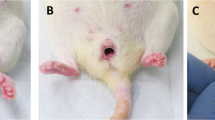Abstract
Objective
Tissue ischemia-hypoxia can activate the calpain proteolytic system. Mechanical trauma to the upper vaginal wall and pelvic floor could compromise vascular perfusion and could also result in calpain expression. The aims of this investigation were to assess the expression messenger RNA and proteins for m-calpain and μ-calpain in the vaginal walls of women with and without uterovaginal prolapse.
Methods
The anterior vaginal walls of 22 women with and without uterovaginal prolpase were evaluated using a reverse transcription polymerase chain reaction and western blotting for detecting calpain expression.
Results
The number of messenger RNA transcripts of m- and μ-calpain was significantly less in women with uterovaginal prolapse than in women without uterovaginal prolapse (two of 11 and zero of 11 versus eight of 11 and five of 11, P <.05). All women had m-calpain protein expression in the anterior vaginal wall. However, the concentration of m-calpain protein was less, but not significantly different, in women with uterovaginal prolapse than in the women without uterovaginal prolapse (0.386 ± 0.018 versus 0.439 ± 0.011 optical density/mm2, P >.05). None of the women with uterovaginal prolapse had expression of μ-calpain mRNA or protein (zero of 11). Expression of protein of calpains in the anterior vaginal wall is not consistent with mRNA transcripts.
Conclusion
Calpain expression may be compromised in the anterior vaginal wall of women with uterovaginal prolapse who have abnormal histologic changes in the vaginal connective tissues or have anterior vaginal laxity.
Similar content being viewed by others
References
Smith AR, Hosker GL, Warrell DW. The role of partial denervation of the pelvic floor in the etiology of genitourinary prolapse and stress incontinence of urine: A neurophysiological study. Br J Obstet Gynecol 1989;96:24–8.
Helt M, Benson JT, Russell B, Brubaker L. Levator ani muscle in women with genitourinary prolapse: Indirect assessment by muscle histology. Neurourol Urodyn 1996;15:17–29.
Bergman A, Elia G, Cheung D, Perelma N, Nimmi ME. Biochemical composition of collagen in continent and stress urinary incontinent women. Gynecol Obstet Invest 1994;37:48–51.
Norton PA, Boy C, Deak S. Abnormal collagen ratios in women with genitourinary prolapse. Neurourol Urodyn 1992;11:2–4.
Bidmead J, Cardozo LD. Pelvic floor changes in the older woman. Br J Urol 1998;82(Suppl 1):18–25.
Delancey JOL, Starr RA. Histology of the connection between the vagina and levator ani muscles. J Reprod Med 1990;35:765–71.
Boreham MK, Miller RT, Schaffer JI, Word RA. Smooth muscle myosin heavy chain and caldesmon expression in the anterior vaginal wall of women with and without pelvic floor prolapse. Am J Obstet Gynecol 2001;185:944–52.
Harris TA, Bent AE. Genital prolapse with and without urinary incontinence 1990;35:792–8.
Delancey JOL. Anatomy of the pelvis. In: Thompson JD, Rock JA, eds. Telinde’s operative gynecology. 7th ed. Philadelphia: JB Lippincott, 1992:33–65.
Deshpande RV, Goust JM, Chakrabarti AK, Barbosa E, Hogan EL, Banik NL. Calpain expression in lymphoid cells. Increased mRNA and protein levels after cell activation. J Biol Chem 1995;270:2497–505.
Melloni E, Pontremoli S. The calpains. Trends Neurosci 1989;12:438–44.
Kawasaki H, Imajoh S, Kawashima S, Hayashi H, Suzuki K. The small subunits of calcium dependent proteases with different calcium sensitivities are identical. J Biochem 1986;99:1525–32.
Johnson P, Hammer JL. Cardiac and skeletal muscle enzyme levels in hypertensive and aging rats. Comp Biochem Physiol 1993;104:63–7.
Kampfl A, Posmantur RM, Zhao X, Schmutzhard E, Clifton GL, Hayes RL. Mechanisms of calpain proteolysis following traumatic brain injury: Implications for pathology and therapy—a review and update. J Neurotrauma 1997;14:121–34.
Edelstein CL, Ling H, Schrier RW. The nature of renal cell injury. Kidney Int 1997;51:1341–51.
Levin RM, Levin SS, Wein AJ. Etiology of incontinence: A review and hypothesis. Scand J Urol Nephrol 1996;179(Suppl):15–25.
Fujitani K, Kambayashi J, Sakon M, et al. Identification of μ-, m-calapains and calpastatin and capture of μ-calpain activation in endothelial cells. J Cell Biochem 1997;66:197–209.
Cuervo AM, Dice JF. How do intracellular proteolytic systems change with age? Front Biosci 1998;3:25–43.
Makinen J, Soderstorm KO, Kiilholma P, Hirvonen T. Histological changes in the vaginal connective tissue of patients with and without uterine prolapse. Arch Gynecol 1986;239:17–20.
Bump RC, Mattiasson A, Bo K, Brubaker LP, DeLancey JOL, Klarskov P. The standardization of terminology of female pelvic organ prolapse and pelvic floor dysfunction. Am J Obstet Gynecol 1996;175:10–7.
Glatstein IZ, Yeh J. Ontogeny of the estrogen receptor in the human fetal uterus. J Clin Endocrinol Metab 1995;80:958–64.
Aoki K, Imajoh S, Ohno S, Emori Y, et al. Complete amino acid sequence of the large subunit of the low-Ca2+-requiring form of human Ca2+-activated neutral protease (CANP) deduced from its cDNA sequence. FEBS Lett 1986;205:313–7.
Imajoh S, Aoki K, Ohno S, et al. Molecular cloning of the cDNA for the large subunit of the high-Ca2+-requiring form of human Ca2+-activated neutral protease. Biochemistry 1988;27:8122–8.
Zhang W, Lane RD, Mellgren RL. The major calpain isozymes are long-lived proteins. Design of an antisense strategy for calpain depletion in cultured cells. J Biol Chem 1996;271:18825–30.
Zhao Y, Levin SS, Wein AJ, Levin RM. Correlation of ischemia/perfusion or partial outlet obstruction-induced spectrin proteolysis by calpain with contractile dysfunction in rabbit bladder. Urology 1997;49:293–300.
Chen ZF, Schottler F, Lee KS. Neuronal recovery after moderate hypoxia is improved by the calpain inhibitor MDL28170. Brain Res 1997;769:188–92.
Chen SJ, Bradley ME, Lee TC. Chemical hypoxia triggers apoptosis of cultured neonatal rat cardiac myocytes: Modulation by calcium-regulated proteases and protein kinases. Mol Cell Biochem 1998;178:141–9.
Author information
Authors and Affiliations
Rights and permissions
About this article
Cite this article
Chen, GD., Chen, YC. & Lin, LY. Different Expression of Calpains in the Anterior Vaginal Wall of Women With and Without Uterovaginal Prolapse. Reprod. Sci. 11, 113–117 (2004). https://doi.org/10.1016/j.jsgi.2003.08.006
Published:
Issue Date:
DOI: https://doi.org/10.1016/j.jsgi.2003.08.006




